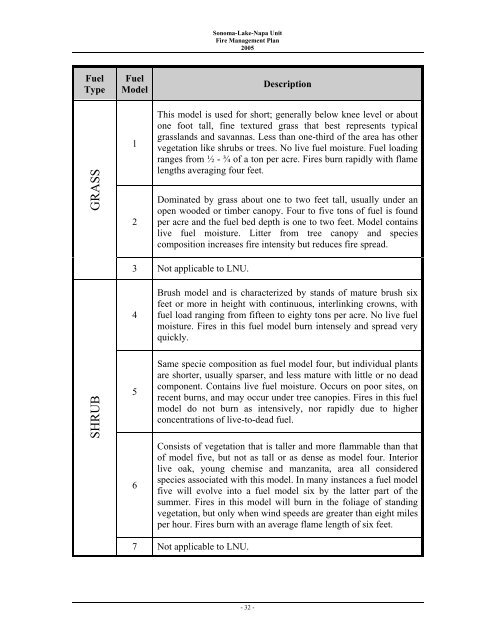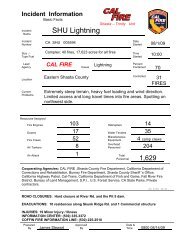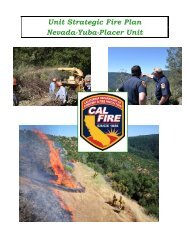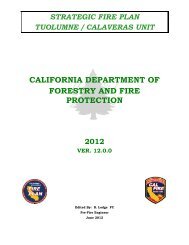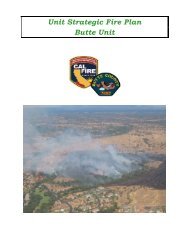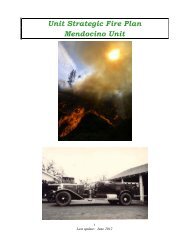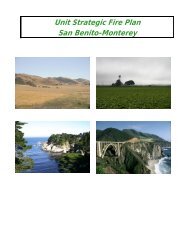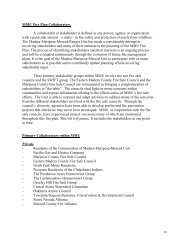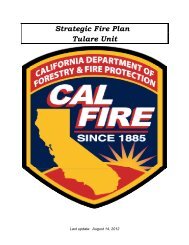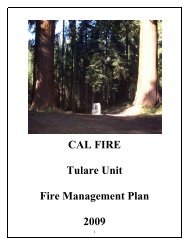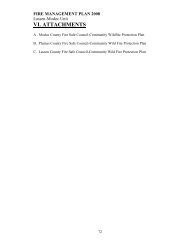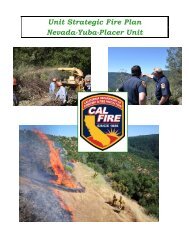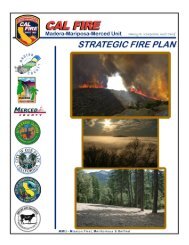Sonoma-Lake-Napa Fire Plan - Board of Forestry and Fire ...
Sonoma-Lake-Napa Fire Plan - Board of Forestry and Fire ...
Sonoma-Lake-Napa Fire Plan - Board of Forestry and Fire ...
You also want an ePaper? Increase the reach of your titles
YUMPU automatically turns print PDFs into web optimized ePapers that Google loves.
Fuel<br />
Type<br />
GRASS<br />
SHRUB<br />
Fuel<br />
Model<br />
1<br />
2<br />
<strong>Sonoma</strong>-<strong>Lake</strong>-<strong>Napa</strong> Unit<br />
<strong>Fire</strong> Management <strong>Plan</strong><br />
2005<br />
Description<br />
This model<br />
is used for short; generally below knee level or about<br />
one foot<br />
tall, fine textured grass that best represents typical<br />
grassl<strong>and</strong>s<br />
<strong>and</strong> savannas. Less than one-third <strong>of</strong> the area has other<br />
vegetation like shrubs or trees. No live fuel moisture. Fuel loading<br />
ranges from<br />
½ - ¾ <strong>of</strong> a ton per acre. <strong>Fire</strong>s burn rapidly with flame<br />
lengths averaging<br />
four feet.<br />
Dominated<br />
by grass about one to two feet tall, usually under an<br />
open wooded<br />
or timber canopy. Four to five tons <strong>of</strong> fuel is found<br />
per acre <strong>and</strong> the fuel bed depth is one to two feet. Model contains<br />
live fuel<br />
moisture. Litter from tree canopy <strong>and</strong> species<br />
composition<br />
increases fire intensity but reduces fire spread.<br />
3 Not applicable to LNU.<br />
4<br />
5<br />
6<br />
Brush model <strong>and</strong> is characterized by st<strong>and</strong>s <strong>of</strong> mature brush six<br />
feet or more in height with continuous, interlinking crowns, with<br />
fuel load ranging from fifteen to eighty tons per acre. No live fuel<br />
moisture. <strong>Fire</strong>s in this fuel model burn intensely <strong>and</strong> spread very<br />
quickly.<br />
Same specie composition as fuel model four, but individual plants<br />
are shorter, usually sparser, <strong>and</strong> less mature with little or no dead<br />
component. Contains live fuel moisture. Occurs on poor sites, on<br />
recent burns, <strong>and</strong> may occur under tree canopies. <strong>Fire</strong>s in this fuel<br />
model do not burn as intensively, nor rapidly due to higher<br />
concentrations <strong>of</strong> live-to-dead fuel.<br />
Consists <strong>of</strong> vegetation that is taller <strong>and</strong> more flammable than that<br />
<strong>of</strong> model five, but not as tall or as dense as model four. Interior<br />
live oak, young chemise <strong>and</strong> manzanita, area all considered<br />
species associated with this model. In many instances a fuel model<br />
five will evolve into a fuel model six by the latter part <strong>of</strong> the<br />
summer. <strong>Fire</strong>s in this model will burn in the foliage <strong>of</strong> st<strong>and</strong>ing<br />
vegetation, but only when wind speeds are greater than eight miles<br />
per hour. <strong>Fire</strong>s burn with an average flame length <strong>of</strong> six feet.<br />
7 Not applicable to LNU.<br />
- 32 -


